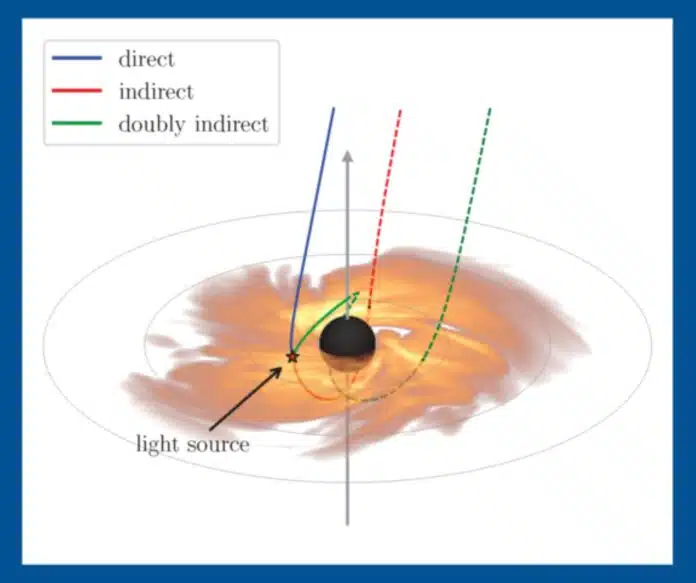
By Amit Malewar 8 Nov, 2024
Collected at: https://www.techexplorist.com/illuminating-black-holes-using-light-echoes/92068/
Due to strong gravitational lensing, light passing near a black hole can take multiple paths, resulting in an “echo” signature in the observed image. The delay in these echoes is primarily influenced by the black hole’s mass spi,n, and inclination relative to the observer.
In the Kerr geometry, the echo images are distorted—demagnified, rotated, and sheared versions of the direct image—and appear within a limited region of the image. These echo images have reduced brightness, and the temporal correlations in the light flow make it difficult to detect them directly from the overall light curve.
A team of astrophysicists, led by scholars from the Institute for Advanced Study, has created a groundbreaking technique to detect black hole light echoes. This new method, which facilitates more accurate measurements of a black hole’s mass and spin, marks a significant advancement in astrophysical research. Unlike previous approaches that relied on different methods to probe these parameters, this technique offers an independent way to gather critical information about black holes.
The research introduces a method that could provide direct evidence of photons orbiting black holes through *gravitational lensing*. This effect occurs when light passes near a black hole, and its path is bent by its intense gravity. As a result, light can take multiple paths from the source to an observer on Earth. Some light rays may travel directly, while others could loop around the black hole once or more times before reaching us. This causes light from the same source to arrive at different times, creating an “echo.”
The study’s lead author, George N. Wong, Frank and Peggy Taplin Member in the Institute’s School of Natural Sciences and Associate Research Scholar at the Princeton Gravity Initiative at Princeton University said, “Our method offers a blueprint for making these measurements, which could potentially revolutionize our understanding of black hole physics.”
The new technique allows scientists to isolate faint echo signatures from the stronger direct light captured by interferometric telescopes like the Event Horizon Telescope. To test the method, the team ran high-resolution simulations, taking tens of thousands of “snapshots” of light traveling around a supermassive black hole similar to the one at the center of the M87 galaxy (M87*), which is about 55 million light-years away.
These simulations demonstrated that the method could accurately infer the echo delay period in the data. The researchers believe this technique can be applied to other black holes beyond just M87*.
“This method will not only confirm the presence of light orbiting a black hole but also serve as a new tool for measuring the black hole’s fundamental properties,” explains Medeiros.
Understanding these properties is crucial because black holes shape the universe’s evolution. According to Wong, while black holes are often known for pulling matter in, they also eject vast amounts of energy, influencing galaxy formation, star development, and the overall structure of galaxies.
By accurately measuring the distribution of black hole masses and spins—and understanding how this distribution evolves over time—scientists can significantly deepen our understanding of the cosmos.
However, measuring a black hole’s mass or spin is challenging. The accretion disk, the rotating disk of hot gas and matter spiraling toward a black hole, can complicate such measurements. Light echoes, on the other hand, provide an independent method for determining mass and spin. Multiple independent measurements allow scientists to produce more reliable and accurate estimates of these critical black hole parameters.
Lia Medeiros, Visitor in the Institute’s School of Natural Sciences said, “Using this technique, we might find things that make us think ‘hey, this is weird!. The analysis of such data could help us to verify whether black holes are indeed consistent with general relativity.”
Journal Reference:
- George N. Wong, Lia Medeiros et al. Measuring Black Hole Light Echoes with Very Long Baseline Interferometry. The Astrophysical Journal Letters. DOI 10.3847/2041-8213/ad8650

Leave a Reply